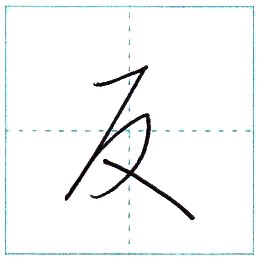今回は、草書の「反」です。
こんかいは、そうしょの「反(はん)」です。
This time is 反(han) in cursive script.

スポンサーリンク
この文字は、行書と草書の形がよく似ています。このように画数が少ない漢字では、行書と草書の区別がつきにくい場合があります。
このもじは、ぎょうしょとそうしょのかたちがよくにています。このようにかくすうがすくないかんじでは、ぎょうしょとそうしょのくべつがつきにくいばあいがあります。
This letter is very similar in semi-cursive and cursive. Like this, in the case of kanji with only a few strokes, it’s sometimes hard to distinguish the two styles.
単語例(たんごれい)
Word examples
反戦 [はんせん han sen] = anti-war
反乱 [はんらん han ran] = revolt, rebellion
反乱軍 [はんらんぐん han ran gun] = rebel army
反日 [はんにち han nichi] = anti-Japanese
⇔親日 [しんにち shin nichi] = pro-Japanese
法に反する [ほうに はんする hou ni han su ru] = against the law
体を反らす [からだを そらす karada o so ra su] = to bend oneself backward
反物 [たんもの tan mono] = fabric for kimono
スポンサーリンク
書き順(かきじゅん)
Stroke order
1. 最初の線は、1画で書きます。
さいしょのせんは、いっかくでかきます。
Write the first line with one stroke.

1-1.

1-2.

2.

3. 完成(かんせい) Finish

公開日/post 2021.04.03
更新日/update 2021.04.03
スポンサーリンク


